Literature Review: Media & Aboriginal People in Post-Apology Era
VerifiedAdded on 2023/04/19
|7
|1860
|429
Literature Review
AI Summary
This literature review investigates the media representation of Aboriginal people in Australia, particularly within the context of political journalism and racial hegemony. It analyzes the prevalence of racial stereotypes, the framing of Aboriginal issues, and the structural impacts of media coverage. The review draws upon existing research to identify gaps in the literature and proposes research questions to guide further investigation into the state of media representation of Aboriginal people in the Australian media, focusing on content analysis of ABC News Online from 2008-2018 and integrating critical discourse analysis.
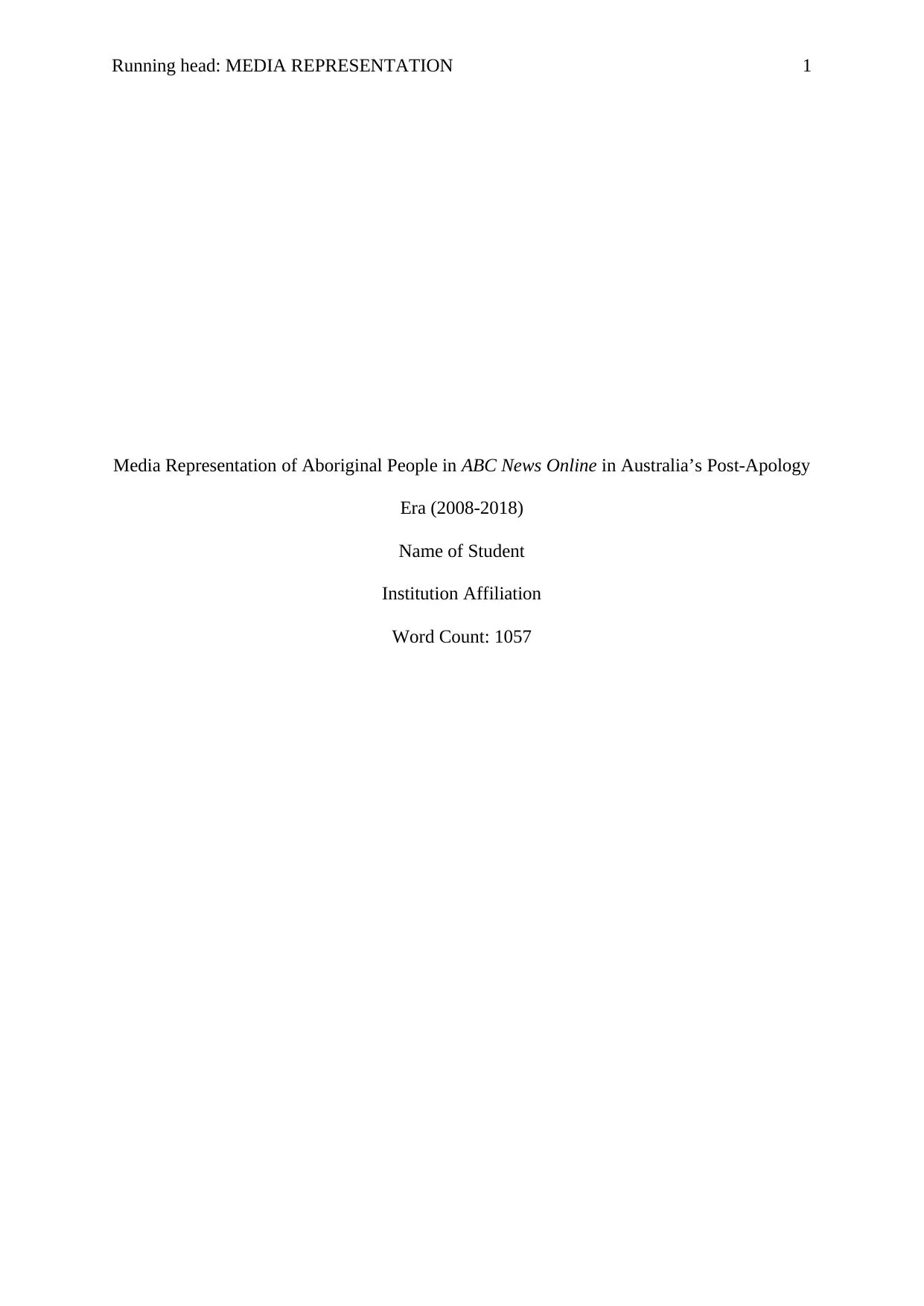
Running head: MEDIA REPRESENTATION 1
Media Representation of Aboriginal People in ABC News Online in Australia’s Post-Apology
Era (2008-2018)
Name of Student
Institution Affiliation
Word Count: 1057
Media Representation of Aboriginal People in ABC News Online in Australia’s Post-Apology
Era (2008-2018)
Name of Student
Institution Affiliation
Word Count: 1057
Paraphrase This Document
Need a fresh take? Get an instant paraphrase of this document with our AI Paraphraser
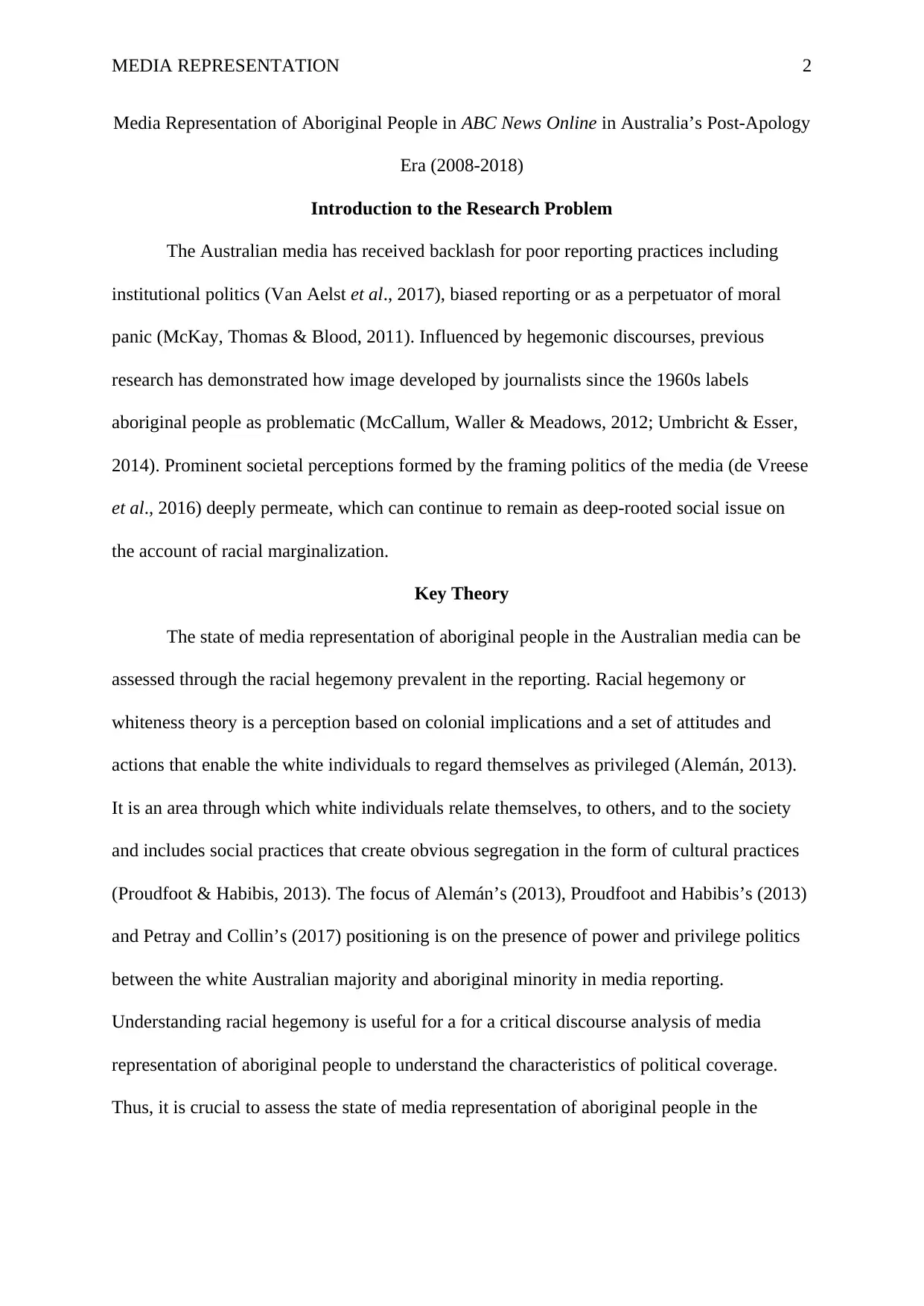
MEDIA REPRESENTATION 2
Media Representation of Aboriginal People in ABC News Online in Australia’s Post-Apology
Era (2008-2018)
Introduction to the Research Problem
The Australian media has received backlash for poor reporting practices including
institutional politics (Van Aelst et al., 2017), biased reporting or as a perpetuator of moral
panic (McKay, Thomas & Blood, 2011). Influenced by hegemonic discourses, previous
research has demonstrated how image developed by journalists since the 1960s labels
aboriginal people as problematic (McCallum, Waller & Meadows, 2012; Umbricht & Esser,
2014). Prominent societal perceptions formed by the framing politics of the media (de Vreese
et al., 2016) deeply permeate, which can continue to remain as deep-rooted social issue on
the account of racial marginalization.
Key Theory
The state of media representation of aboriginal people in the Australian media can be
assessed through the racial hegemony prevalent in the reporting. Racial hegemony or
whiteness theory is a perception based on colonial implications and a set of attitudes and
actions that enable the white individuals to regard themselves as privileged (Alemán, 2013).
It is an area through which white individuals relate themselves, to others, and to the society
and includes social practices that create obvious segregation in the form of cultural practices
(Proudfoot & Habibis, 2013). The focus of Alemán’s (2013), Proudfoot and Habibis’s (2013)
and Petray and Collin’s (2017) positioning is on the presence of power and privilege politics
between the white Australian majority and aboriginal minority in media reporting.
Understanding racial hegemony is useful for a for a critical discourse analysis of media
representation of aboriginal people to understand the characteristics of political coverage.
Thus, it is crucial to assess the state of media representation of aboriginal people in the
Media Representation of Aboriginal People in ABC News Online in Australia’s Post-Apology
Era (2008-2018)
Introduction to the Research Problem
The Australian media has received backlash for poor reporting practices including
institutional politics (Van Aelst et al., 2017), biased reporting or as a perpetuator of moral
panic (McKay, Thomas & Blood, 2011). Influenced by hegemonic discourses, previous
research has demonstrated how image developed by journalists since the 1960s labels
aboriginal people as problematic (McCallum, Waller & Meadows, 2012; Umbricht & Esser,
2014). Prominent societal perceptions formed by the framing politics of the media (de Vreese
et al., 2016) deeply permeate, which can continue to remain as deep-rooted social issue on
the account of racial marginalization.
Key Theory
The state of media representation of aboriginal people in the Australian media can be
assessed through the racial hegemony prevalent in the reporting. Racial hegemony or
whiteness theory is a perception based on colonial implications and a set of attitudes and
actions that enable the white individuals to regard themselves as privileged (Alemán, 2013).
It is an area through which white individuals relate themselves, to others, and to the society
and includes social practices that create obvious segregation in the form of cultural practices
(Proudfoot & Habibis, 2013). The focus of Alemán’s (2013), Proudfoot and Habibis’s (2013)
and Petray and Collin’s (2017) positioning is on the presence of power and privilege politics
between the white Australian majority and aboriginal minority in media reporting.
Understanding racial hegemony is useful for a for a critical discourse analysis of media
representation of aboriginal people to understand the characteristics of political coverage.
Thus, it is crucial to assess the state of media representation of aboriginal people in the
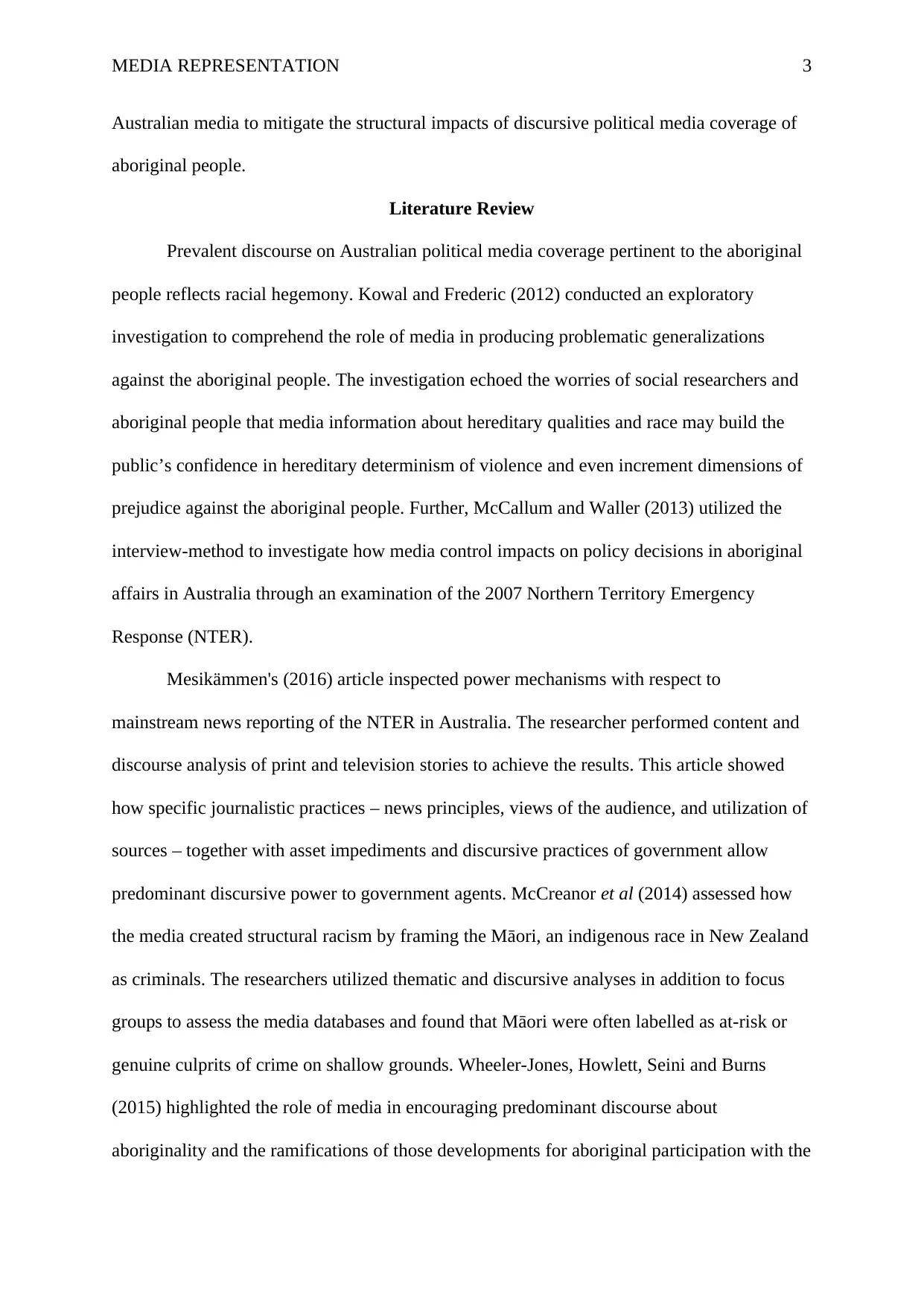
MEDIA REPRESENTATION 3
Australian media to mitigate the structural impacts of discursive political media coverage of
aboriginal people.
Literature Review
Prevalent discourse on Australian political media coverage pertinent to the aboriginal
people reflects racial hegemony. Kowal and Frederic (2012) conducted an exploratory
investigation to comprehend the role of media in producing problematic generalizations
against the aboriginal people. The investigation echoed the worries of social researchers and
aboriginal people that media information about hereditary qualities and race may build the
public’s confidence in hereditary determinism of violence and even increment dimensions of
prejudice against the aboriginal people. Further, McCallum and Waller (2013) utilized the
interview-method to investigate how media control impacts on policy decisions in aboriginal
affairs in Australia through an examination of the 2007 Northern Territory Emergency
Response (NTER).
Mesikämmen's (2016) article inspected power mechanisms with respect to
mainstream news reporting of the NTER in Australia. The researcher performed content and
discourse analysis of print and television stories to achieve the results. This article showed
how specific journalistic practices – news principles, views of the audience, and utilization of
sources – together with asset impediments and discursive practices of government allow
predominant discursive power to government agents. McCreanor et al (2014) assessed how
the media created structural racism by framing the Māori, an indigenous race in New Zealand
as criminals. The researchers utilized thematic and discursive analyses in addition to focus
groups to assess the media databases and found that Māori were often labelled as at-risk or
genuine culprits of crime on shallow grounds. Wheeler-Jones, Howlett, Seini and Burns
(2015) highlighted the role of media in encouraging predominant discourse about
aboriginality and the ramifications of those developments for aboriginal participation with the
Australian media to mitigate the structural impacts of discursive political media coverage of
aboriginal people.
Literature Review
Prevalent discourse on Australian political media coverage pertinent to the aboriginal
people reflects racial hegemony. Kowal and Frederic (2012) conducted an exploratory
investigation to comprehend the role of media in producing problematic generalizations
against the aboriginal people. The investigation echoed the worries of social researchers and
aboriginal people that media information about hereditary qualities and race may build the
public’s confidence in hereditary determinism of violence and even increment dimensions of
prejudice against the aboriginal people. Further, McCallum and Waller (2013) utilized the
interview-method to investigate how media control impacts on policy decisions in aboriginal
affairs in Australia through an examination of the 2007 Northern Territory Emergency
Response (NTER).
Mesikämmen's (2016) article inspected power mechanisms with respect to
mainstream news reporting of the NTER in Australia. The researcher performed content and
discourse analysis of print and television stories to achieve the results. This article showed
how specific journalistic practices – news principles, views of the audience, and utilization of
sources – together with asset impediments and discursive practices of government allow
predominant discursive power to government agents. McCreanor et al (2014) assessed how
the media created structural racism by framing the Māori, an indigenous race in New Zealand
as criminals. The researchers utilized thematic and discursive analyses in addition to focus
groups to assess the media databases and found that Māori were often labelled as at-risk or
genuine culprits of crime on shallow grounds. Wheeler-Jones, Howlett, Seini and Burns
(2015) highlighted the role of media in encouraging predominant discourse about
aboriginality and the ramifications of those developments for aboriginal participation with the
⊘ This is a preview!⊘
Do you want full access?
Subscribe today to unlock all pages.

Trusted by 1+ million students worldwide
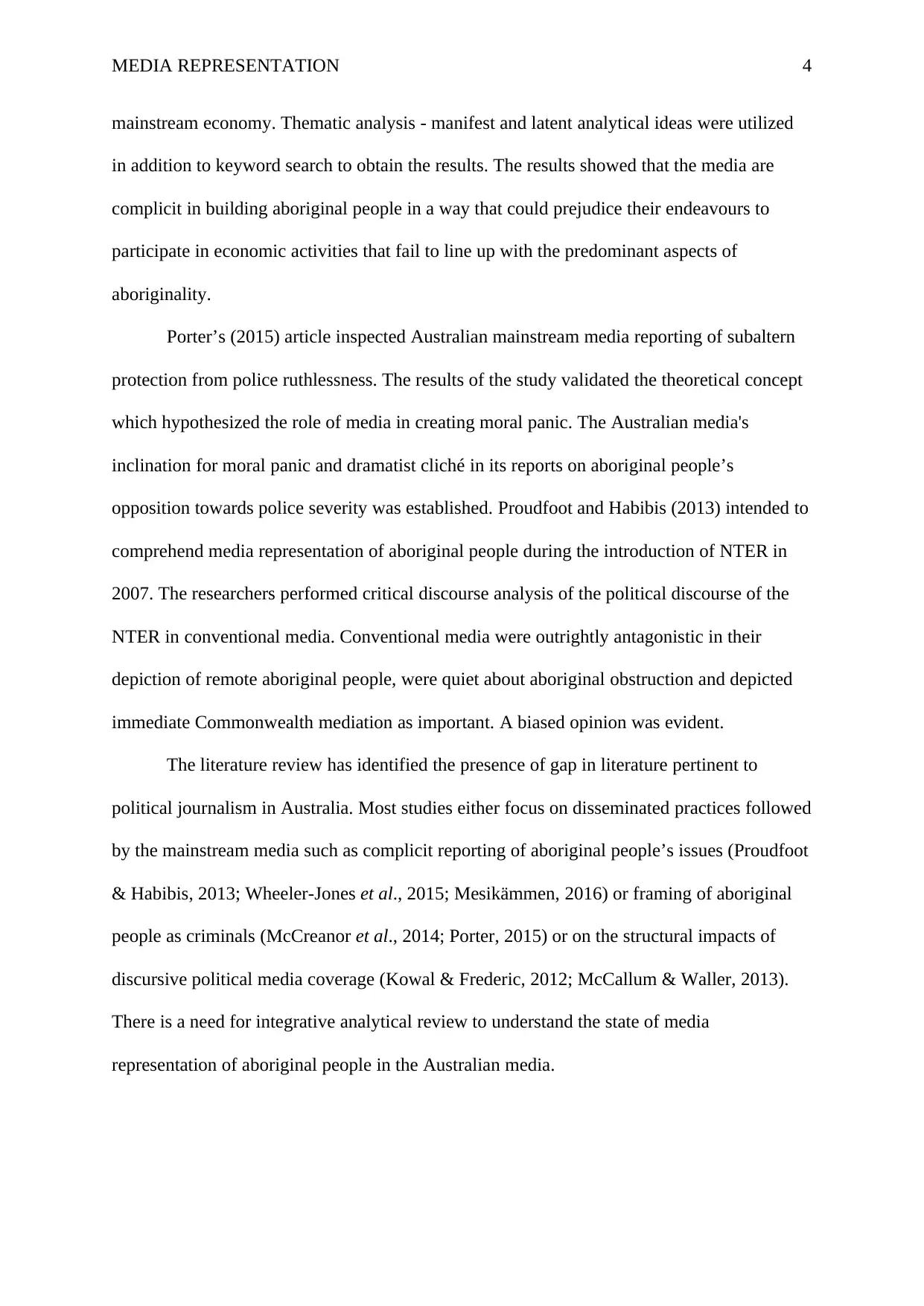
MEDIA REPRESENTATION 4
mainstream economy. Thematic analysis - manifest and latent analytical ideas were utilized
in addition to keyword search to obtain the results. The results showed that the media are
complicit in building aboriginal people in a way that could prejudice their endeavours to
participate in economic activities that fail to line up with the predominant aspects of
aboriginality.
Porter’s (2015) article inspected Australian mainstream media reporting of subaltern
protection from police ruthlessness. The results of the study validated the theoretical concept
which hypothesized the role of media in creating moral panic. The Australian media's
inclination for moral panic and dramatist cliché in its reports on aboriginal people’s
opposition towards police severity was established. Proudfoot and Habibis (2013) intended to
comprehend media representation of aboriginal people during the introduction of NTER in
2007. The researchers performed critical discourse analysis of the political discourse of the
NTER in conventional media. Conventional media were outrightly antagonistic in their
depiction of remote aboriginal people, were quiet about aboriginal obstruction and depicted
immediate Commonwealth mediation as important. A biased opinion was evident.
The literature review has identified the presence of gap in literature pertinent to
political journalism in Australia. Most studies either focus on disseminated practices followed
by the mainstream media such as complicit reporting of aboriginal people’s issues (Proudfoot
& Habibis, 2013; Wheeler-Jones et al., 2015; Mesikämmen, 2016) or framing of aboriginal
people as criminals (McCreanor et al., 2014; Porter, 2015) or on the structural impacts of
discursive political media coverage (Kowal & Frederic, 2012; McCallum & Waller, 2013).
There is a need for integrative analytical review to understand the state of media
representation of aboriginal people in the Australian media.
mainstream economy. Thematic analysis - manifest and latent analytical ideas were utilized
in addition to keyword search to obtain the results. The results showed that the media are
complicit in building aboriginal people in a way that could prejudice their endeavours to
participate in economic activities that fail to line up with the predominant aspects of
aboriginality.
Porter’s (2015) article inspected Australian mainstream media reporting of subaltern
protection from police ruthlessness. The results of the study validated the theoretical concept
which hypothesized the role of media in creating moral panic. The Australian media's
inclination for moral panic and dramatist cliché in its reports on aboriginal people’s
opposition towards police severity was established. Proudfoot and Habibis (2013) intended to
comprehend media representation of aboriginal people during the introduction of NTER in
2007. The researchers performed critical discourse analysis of the political discourse of the
NTER in conventional media. Conventional media were outrightly antagonistic in their
depiction of remote aboriginal people, were quiet about aboriginal obstruction and depicted
immediate Commonwealth mediation as important. A biased opinion was evident.
The literature review has identified the presence of gap in literature pertinent to
political journalism in Australia. Most studies either focus on disseminated practices followed
by the mainstream media such as complicit reporting of aboriginal people’s issues (Proudfoot
& Habibis, 2013; Wheeler-Jones et al., 2015; Mesikämmen, 2016) or framing of aboriginal
people as criminals (McCreanor et al., 2014; Porter, 2015) or on the structural impacts of
discursive political media coverage (Kowal & Frederic, 2012; McCallum & Waller, 2013).
There is a need for integrative analytical review to understand the state of media
representation of aboriginal people in the Australian media.
Paraphrase This Document
Need a fresh take? Get an instant paraphrase of this document with our AI Paraphraser
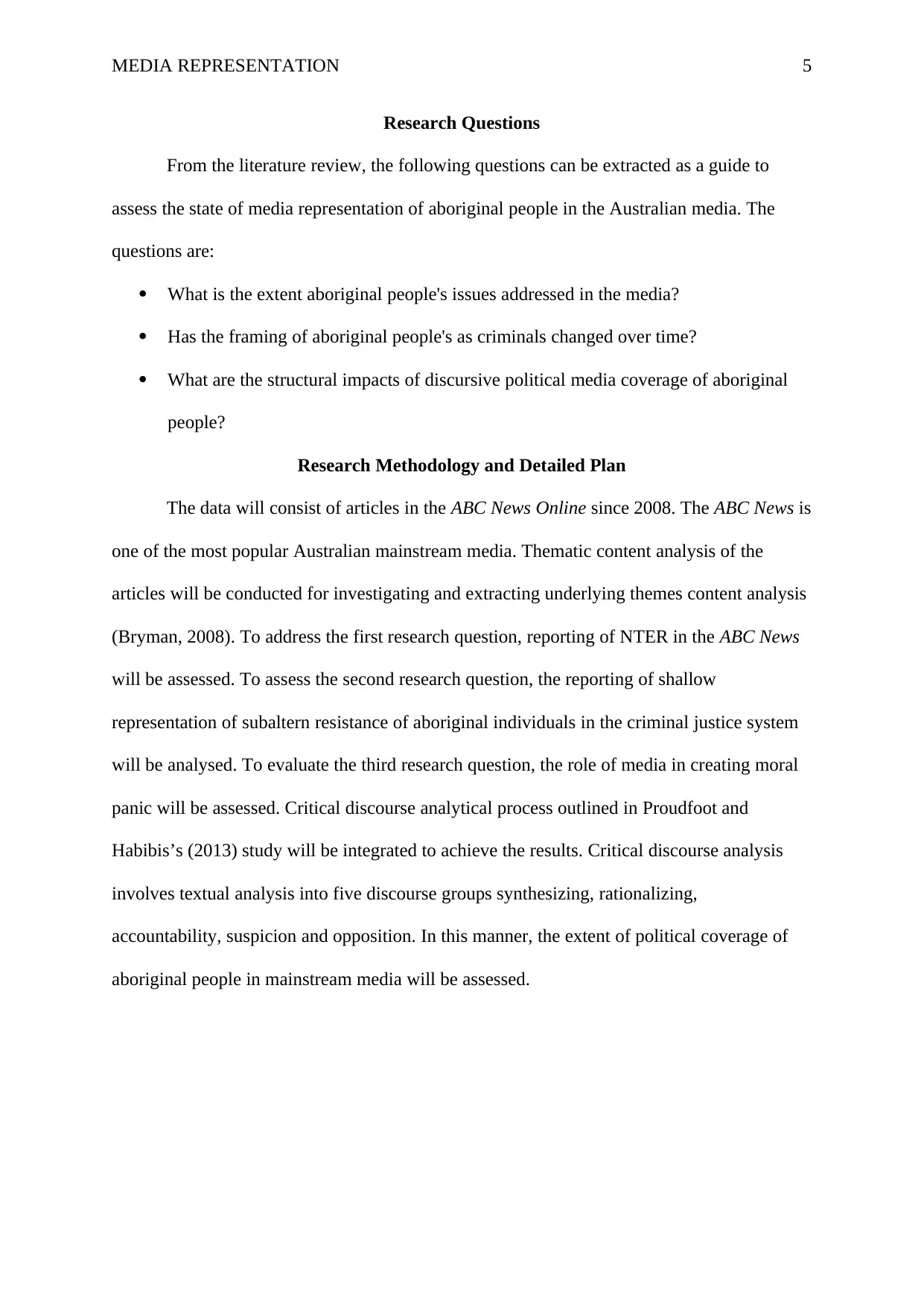
MEDIA REPRESENTATION 5
Research Questions
From the literature review, the following questions can be extracted as a guide to
assess the state of media representation of aboriginal people in the Australian media. The
questions are:
What is the extent aboriginal people's issues addressed in the media?
Has the framing of aboriginal people's as criminals changed over time?
What are the structural impacts of discursive political media coverage of aboriginal
people?
Research Methodology and Detailed Plan
The data will consist of articles in the ABC News Online since 2008. The ABC News is
one of the most popular Australian mainstream media. Thematic content analysis of the
articles will be conducted for investigating and extracting underlying themes content analysis
(Bryman, 2008). To address the first research question, reporting of NTER in the ABC News
will be assessed. To assess the second research question, the reporting of shallow
representation of subaltern resistance of aboriginal individuals in the criminal justice system
will be analysed. To evaluate the third research question, the role of media in creating moral
panic will be assessed. Critical discourse analytical process outlined in Proudfoot and
Habibis’s (2013) study will be integrated to achieve the results. Critical discourse analysis
involves textual analysis into five discourse groups synthesizing, rationalizing,
accountability, suspicion and opposition. In this manner, the extent of political coverage of
aboriginal people in mainstream media will be assessed.
Research Questions
From the literature review, the following questions can be extracted as a guide to
assess the state of media representation of aboriginal people in the Australian media. The
questions are:
What is the extent aboriginal people's issues addressed in the media?
Has the framing of aboriginal people's as criminals changed over time?
What are the structural impacts of discursive political media coverage of aboriginal
people?
Research Methodology and Detailed Plan
The data will consist of articles in the ABC News Online since 2008. The ABC News is
one of the most popular Australian mainstream media. Thematic content analysis of the
articles will be conducted for investigating and extracting underlying themes content analysis
(Bryman, 2008). To address the first research question, reporting of NTER in the ABC News
will be assessed. To assess the second research question, the reporting of shallow
representation of subaltern resistance of aboriginal individuals in the criminal justice system
will be analysed. To evaluate the third research question, the role of media in creating moral
panic will be assessed. Critical discourse analytical process outlined in Proudfoot and
Habibis’s (2013) study will be integrated to achieve the results. Critical discourse analysis
involves textual analysis into five discourse groups synthesizing, rationalizing,
accountability, suspicion and opposition. In this manner, the extent of political coverage of
aboriginal people in mainstream media will be assessed.
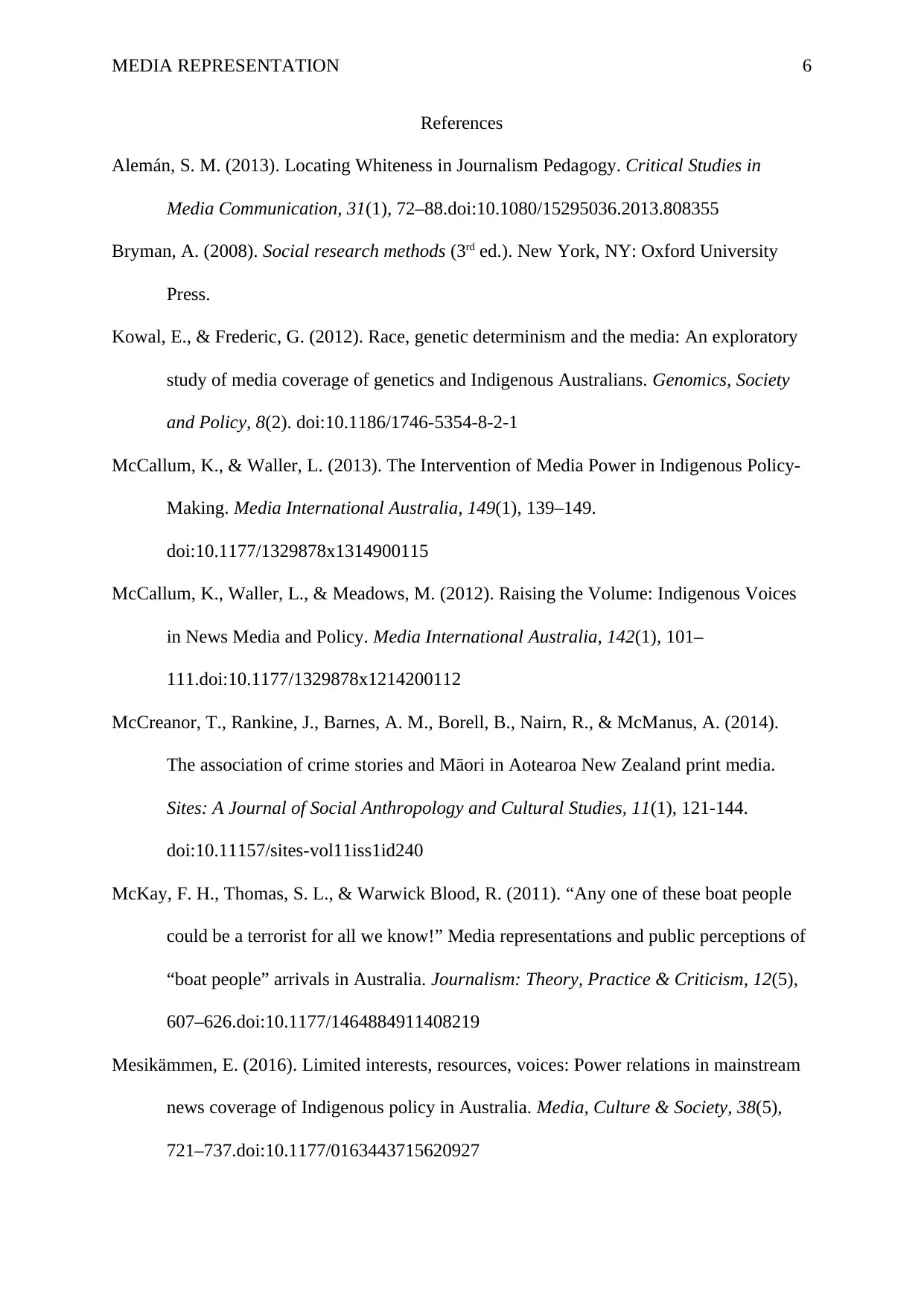
MEDIA REPRESENTATION 6
References
Alemán, S. M. (2013). Locating Whiteness in Journalism Pedagogy. Critical Studies in
Media Communication, 31(1), 72–88.doi:10.1080/15295036.2013.808355
Bryman, A. (2008). Social research methods (3rd ed.). New York, NY: Oxford University
Press.
Kowal, E., & Frederic, G. (2012). Race, genetic determinism and the media: An exploratory
study of media coverage of genetics and Indigenous Australians. Genomics, Society
and Policy, 8(2). doi:10.1186/1746-5354-8-2-1
McCallum, K., & Waller, L. (2013). The Intervention of Media Power in Indigenous Policy-
Making. Media International Australia, 149(1), 139–149.
doi:10.1177/1329878x1314900115
McCallum, K., Waller, L., & Meadows, M. (2012). Raising the Volume: Indigenous Voices
in News Media and Policy. Media International Australia, 142(1), 101–
111.doi:10.1177/1329878x1214200112
McCreanor, T., Rankine, J., Barnes, A. M., Borell, B., Nairn, R., & McManus, A. (2014).
The association of crime stories and Māori in Aotearoa New Zealand print media.
Sites: A Journal of Social Anthropology and Cultural Studies, 11(1), 121-144.
doi:10.11157/sites-vol11iss1id240
McKay, F. H., Thomas, S. L., & Warwick Blood, R. (2011). “Any one of these boat people
could be a terrorist for all we know!” Media representations and public perceptions of
“boat people” arrivals in Australia. Journalism: Theory, Practice & Criticism, 12(5),
607–626.doi:10.1177/1464884911408219
Mesikämmen, E. (2016). Limited interests, resources, voices: Power relations in mainstream
news coverage of Indigenous policy in Australia. Media, Culture & Society, 38(5),
721–737.doi:10.1177/0163443715620927
References
Alemán, S. M. (2013). Locating Whiteness in Journalism Pedagogy. Critical Studies in
Media Communication, 31(1), 72–88.doi:10.1080/15295036.2013.808355
Bryman, A. (2008). Social research methods (3rd ed.). New York, NY: Oxford University
Press.
Kowal, E., & Frederic, G. (2012). Race, genetic determinism and the media: An exploratory
study of media coverage of genetics and Indigenous Australians. Genomics, Society
and Policy, 8(2). doi:10.1186/1746-5354-8-2-1
McCallum, K., & Waller, L. (2013). The Intervention of Media Power in Indigenous Policy-
Making. Media International Australia, 149(1), 139–149.
doi:10.1177/1329878x1314900115
McCallum, K., Waller, L., & Meadows, M. (2012). Raising the Volume: Indigenous Voices
in News Media and Policy. Media International Australia, 142(1), 101–
111.doi:10.1177/1329878x1214200112
McCreanor, T., Rankine, J., Barnes, A. M., Borell, B., Nairn, R., & McManus, A. (2014).
The association of crime stories and Māori in Aotearoa New Zealand print media.
Sites: A Journal of Social Anthropology and Cultural Studies, 11(1), 121-144.
doi:10.11157/sites-vol11iss1id240
McKay, F. H., Thomas, S. L., & Warwick Blood, R. (2011). “Any one of these boat people
could be a terrorist for all we know!” Media representations and public perceptions of
“boat people” arrivals in Australia. Journalism: Theory, Practice & Criticism, 12(5),
607–626.doi:10.1177/1464884911408219
Mesikämmen, E. (2016). Limited interests, resources, voices: Power relations in mainstream
news coverage of Indigenous policy in Australia. Media, Culture & Society, 38(5),
721–737.doi:10.1177/0163443715620927
⊘ This is a preview!⊘
Do you want full access?
Subscribe today to unlock all pages.

Trusted by 1+ million students worldwide
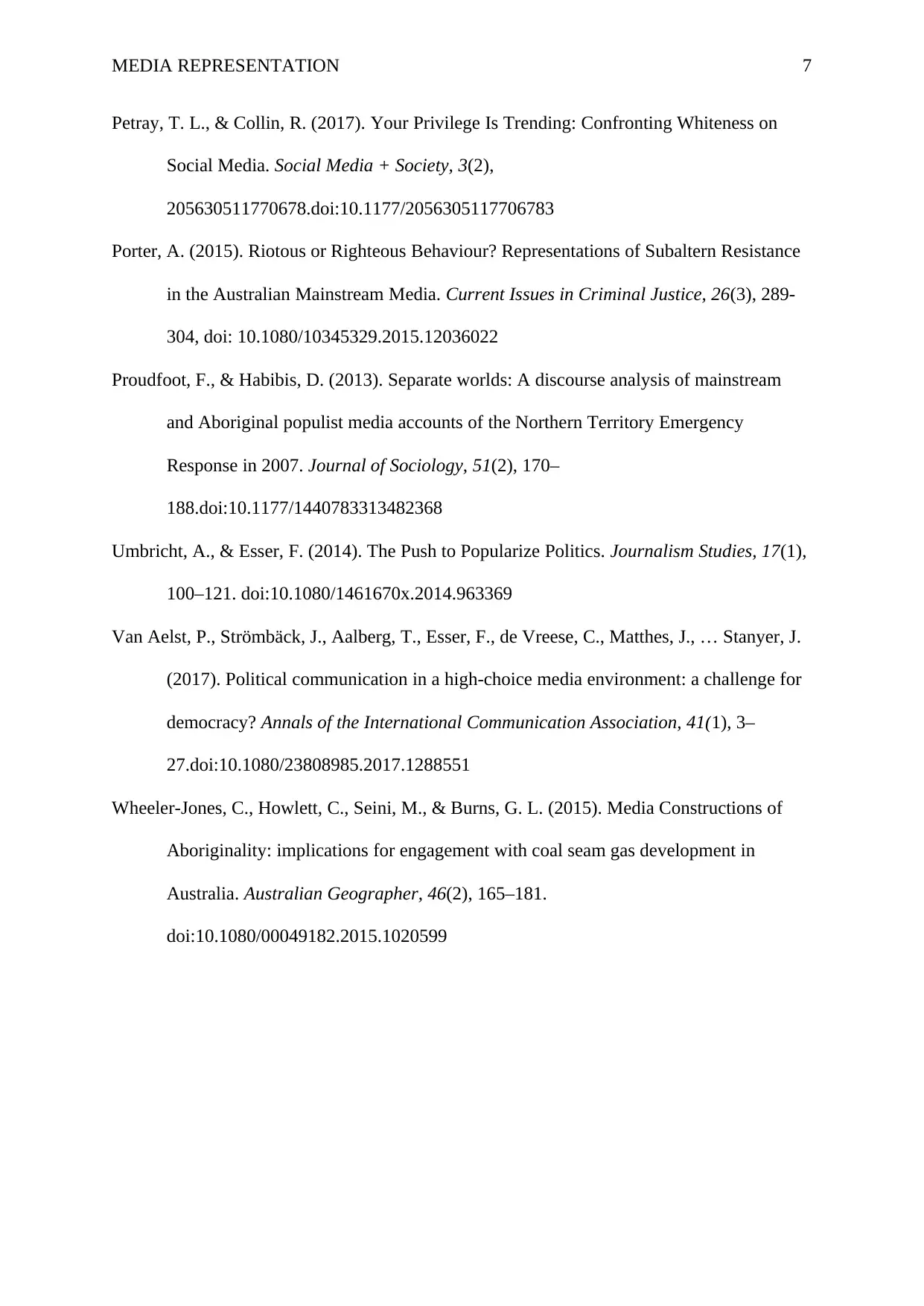
MEDIA REPRESENTATION 7
Petray, T. L., & Collin, R. (2017). Your Privilege Is Trending: Confronting Whiteness on
Social Media. Social Media + Society, 3(2),
205630511770678.doi:10.1177/2056305117706783
Porter, A. (2015). Riotous or Righteous Behaviour? Representations of Subaltern Resistance
in the Australian Mainstream Media. Current Issues in Criminal Justice, 26(3), 289-
304, doi: 10.1080/10345329.2015.12036022
Proudfoot, F., & Habibis, D. (2013). Separate worlds: A discourse analysis of mainstream
and Aboriginal populist media accounts of the Northern Territory Emergency
Response in 2007. Journal of Sociology, 51(2), 170–
188.doi:10.1177/1440783313482368
Umbricht, A., & Esser, F. (2014). The Push to Popularize Politics. Journalism Studies, 17(1),
100–121. doi:10.1080/1461670x.2014.963369
Van Aelst, P., Strömbäck, J., Aalberg, T., Esser, F., de Vreese, C., Matthes, J., … Stanyer, J.
(2017). Political communication in a high-choice media environment: a challenge for
democracy? Annals of the International Communication Association, 41(1), 3–
27.doi:10.1080/23808985.2017.1288551
Wheeler-Jones, C., Howlett, C., Seini, M., & Burns, G. L. (2015). Media Constructions of
Aboriginality: implications for engagement with coal seam gas development in
Australia. Australian Geographer, 46(2), 165–181.
doi:10.1080/00049182.2015.1020599
Petray, T. L., & Collin, R. (2017). Your Privilege Is Trending: Confronting Whiteness on
Social Media. Social Media + Society, 3(2),
205630511770678.doi:10.1177/2056305117706783
Porter, A. (2015). Riotous or Righteous Behaviour? Representations of Subaltern Resistance
in the Australian Mainstream Media. Current Issues in Criminal Justice, 26(3), 289-
304, doi: 10.1080/10345329.2015.12036022
Proudfoot, F., & Habibis, D. (2013). Separate worlds: A discourse analysis of mainstream
and Aboriginal populist media accounts of the Northern Territory Emergency
Response in 2007. Journal of Sociology, 51(2), 170–
188.doi:10.1177/1440783313482368
Umbricht, A., & Esser, F. (2014). The Push to Popularize Politics. Journalism Studies, 17(1),
100–121. doi:10.1080/1461670x.2014.963369
Van Aelst, P., Strömbäck, J., Aalberg, T., Esser, F., de Vreese, C., Matthes, J., … Stanyer, J.
(2017). Political communication in a high-choice media environment: a challenge for
democracy? Annals of the International Communication Association, 41(1), 3–
27.doi:10.1080/23808985.2017.1288551
Wheeler-Jones, C., Howlett, C., Seini, M., & Burns, G. L. (2015). Media Constructions of
Aboriginality: implications for engagement with coal seam gas development in
Australia. Australian Geographer, 46(2), 165–181.
doi:10.1080/00049182.2015.1020599
1 out of 7
Your All-in-One AI-Powered Toolkit for Academic Success.
+13062052269
info@desklib.com
Available 24*7 on WhatsApp / Email
![[object Object]](/_next/static/media/star-bottom.7253800d.svg)
Unlock your academic potential
Copyright © 2020–2025 A2Z Services. All Rights Reserved. Developed and managed by ZUCOL.
